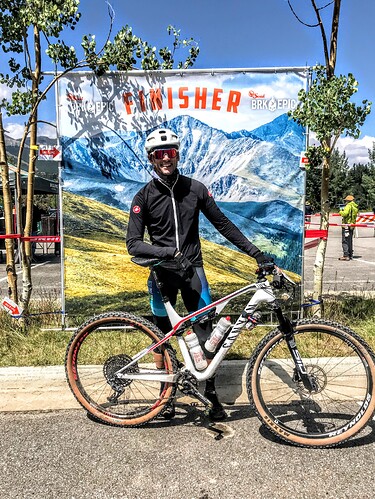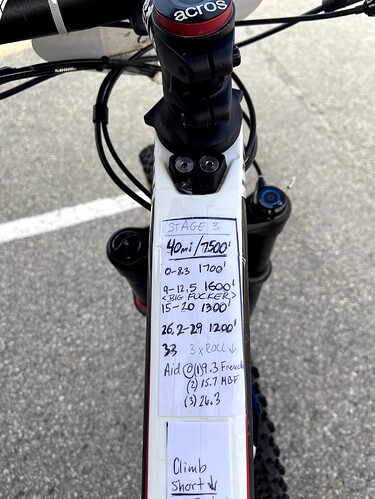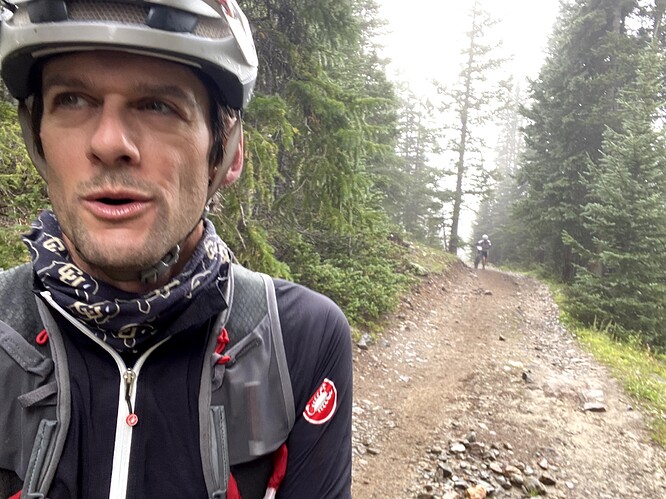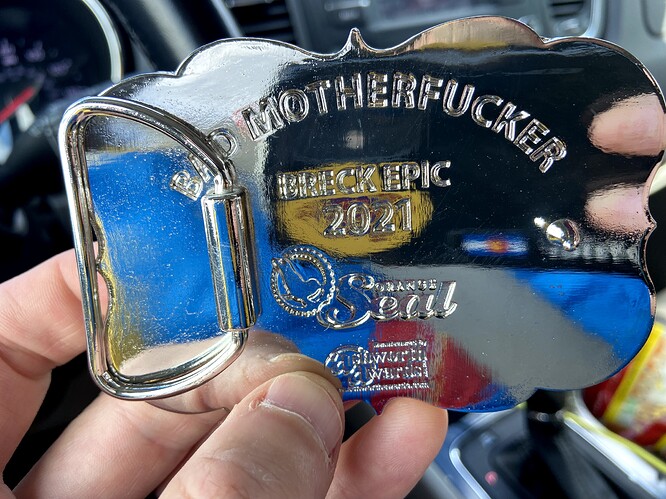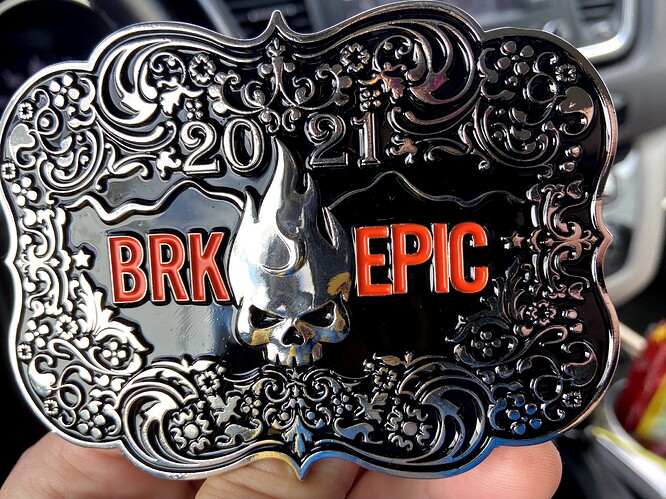Whew! I couldn’t believe it when I crossed the finish line on day 6! Descending on the final 7 miles of dirt and singletrack was surreal. I was going waaaaaaaaaay faster than I should have, but the excitement of finishing what initially seemed like an insurmountable task was too much - the body just flowed over rocks, roots, through switchbacks, and got me my best finish of the entire week on the last day. (If that sounds familiar, it’s for good reason. The body still thought I was Running from Lions 6 days later! And I felt like I could have outrun a lion at that point too!)
A quick recap for anyone who hasn’t followed from the beginning of this N1 Challenge.
The Breck Epic was my selection for the challenge. As a time-crunched athlete and passionate mountain biker, it made sense to go into a 6-day stage race above 9,000 feet elevation. Over the course of this week, every ounce of my preparedness would be tested on a daily basis.
6 days, 240 miles of dirt, 40,000 feet of elevation gain.
Here’s the daily recap:
Day 1
I was excited at the line. There were a lot of people around, laughter, great music, and a race director that knew how to get everyone pumped up. Ok, I was also scared…like, really scared!
One day? Sure, I could do that. But I didn’t want to be the first DNF either - and that was stuck in my head, knowing that in all of my training, I don’t think I ever achieved over 6,000 feet of climbing in 35 miles. 
Anyway, day 1 was Pennsylvania Creek. To be honest, I don’t even remember this stage. The only thing I remember is that it was a kick in the teeth. In Mike Mac’s (the race director) defense, he warned us about this stage. This was the day where if you didn’t already have respect for what you were up against, you developed that respect in the first 5 miles.
Crossing the line that day, the body was in a state of shock. I came back to the house, started eating and drinking, and thinking about what I had just gotten myself info. 
Day 2
Waking up for day 2 was brutal. I was watching my Whoop strap and other metrics daily as I tried to get a sense for how the body was doing. The key? Don’t look at your recovery score before the start of the stage! Save that for after, when your brain is already fried. Then you won’t be surprised by what you see. Upon arrival to 9000+ feet on day zero, my SaO2 dropped off a cliff (like mid-upper 80s) overnight, so sleeping was its own task, constantly waking up and never getting quality rest. By day 2, things were starting to bounce back, slightly. Resting HR looked like an airplane taking off as my body started its acclimatization process. But there was nothing more to do than put your leg over the bike again and get after it.
Day 2 was the Colorado Trail - 43 miles and nearly 8000’ vertical gain. I’ve ridden a portion of this segment in the past, so I knew what to expect, and was properly scared of this stage. But the plan was simple. Start easy, stay as easy as possible. There were 2 questions that guided this process on the climbs:
- Can I put more pressure on the pedals?
- Should I put more pressure on the pedals?
Most of the time #1 was an easy “yes.” However, #2 was mostly a “no.” So as simple as it sounded, that was my pacing strategy. Enjoy the downhills, and ask yourself those questions on every single climb. What made this stage stand out is that we had a large climb up to the Colorado Trail where you were pretty far out in the backcountry, so safety was paramount (e.g., don’t do anything dumb, be aware of your surroundings). That climb was a mixture of riding and hike-a-bike for me because the legs were just not there. I was waiting for the catecholamines to really get going, and thanks to @trevor’s text the night before, I was expecting to just make it through this second day lull before starting to feel better again.
So after the CT climb and descent, we had 3 progressively larger climbs to return back to Breckenridge. I got through the first and second fine. I thought I was going to make it over the 3rd climb, and was only about 1.5 rolling miles from the top when the wheels came off the wagon as if they were never even screwed on in the first place. I don’t think I ever cracked so hard in my life. I was walking a 3% switchback grade. That’s how bad it was. When I rolled across the line, I was shattered. The mind was immediately looking for any reason to not have to get on the bike for day 3. So what happened after that?
Well, I got back to the house, started eating and drinking, kept my legs up, and pretty much didn’t go more than 30 minutes without having something to eat or drink. Went to bed that night, and reluctantly woke up for day 3, expecting the worst.
Day 3
Mount Guyot - 40 miles, 7600’ climbing
Out of the valley! As I was putting my course notes together on my top tube the night before, you can see how I felt about today’s stage, the circumnavigation of Mount Guyot. 
This stage would have us crossing the continental divide twice as we rode around Mount Guyot, a 13,000’ peak in Summit county. This was the day when I came out of the dark! The catecholamines were flowing and as I started pedaling uphill, the legs felt pretty good. Not great, but “good” was an amazing feeling at this point! The plan today was to be conservative. Find “my people” that I was riding with early in the previous 2 stages and actually let them go ahead today. Pacing was going a little too easy to start, but it paid off. We had a good amount of hike-a-bike on today’s stage, and I saw a number of riders trying to ride sections that most were walking. That was a bad idea - I saw them later on in the day, and then didn’t see them the following days because they burned too many matches. Oh, and the views were spectacular!
Overall, this day was pretty spectacular. I finished with some energy to spare, found my rhythm, and maintained the recovery practices of the past 2 days. As was stated multiple times since we started this adventure, the Breck Epic is a recovery contest, with some mountain biking sprinkled in over the week. Back to bed and actually looking forward to stage 4 at this point!
Day 4
The Aqueduct - 43 miles and nearly 8000’ vertical again.
In talking with other riders who have done this before, they said this stage is just “meh.” They said you just need to get through this one. It’s not known for its views, and it’s a pretty rough course with a 12 mile, 2000’ climb in the middle of it. I have to say I wasn’t looking forward to this initially, but actually had a really good day. Pacing myself on day 3 really helped and the legs were still feeling pretty solid today. The mood was really good too. What I noticed on this stage is that the durability I developed through training was really shining through by this point. On that 12 mile climb, I was passing a lot of riders by being able to hold a steady pace. It wasn’t fast by any stretch of the imagination, but it was enough to move along the course at a very consistent pace with little to no change in that pace brought on by fatigue. Getting to the top and feeling like I found my rhythm was the boost I needed to turn things around. I finished this day with great sensations in the legs and a great mood leading into stage 5. What about the weather? Surely every day couldn’t have been the picturesque Colorado blue sky days that we know and love, right? Well, stage 5 had some different plans!
Day 5
Wheeler - ‘nuff said. If you know this route, just hearing the name brings chills to your spine and makes lactate ooze from your eyeballs. By the numbers the stage doesn’t look so bad - 25 miles…oh, and 6100’ elevation gain. The trick is that we spend a lot of time above treeline, including two more crossings of the continental divide and achieving 12,500’ in both of those crossings. Let’s talk weather…
This is the day we heard about for a couple days in the pre-race meetings because weather was looking a little scary - chilly start, rain at 9000’, and of course the potential for more of the same with lightning and thunder up high. I decided to start a little heavy on this one and put a couple key things in my pack:
- winter-weight Gore-Tex jersey
- fall-weight windproof gloves (they lasted me all of 3 minutes)
- winter-weight waterproof gloves
- wool beanie
Starting this stage off, I had a thin, wool base layer, my regular jersey, long sleeve jersey, and Castelli rain jacket - the kind where once you put it on you keep it on, otherwise you lose all your body heat. My summer weight gloves were ok in the beginning. We started up in the rain on a wet, rocky, rooty climb for 4 miles until hitting the first aid station. The reason for the early aid station is because after that point we were heading above treeline and were on our own until mile 7 where the famous bacon hand-up is located.
This is my “what have I gotten myself into face?!”
These last 3 miles to the bacon were filled with a lot of hike-a-bike and thinking about Mother Nature, her mood today, and our fragility as humans in these extreme conditions. So today we had mile 7 as our “exit” where if we turned around and descended the dirt road back to the base area because we were concerned about our safety, we would not be penalized if we finished the next day. Awesome! My brain at that point was screaming at me to descend, take the easy out (after grabbing some bacon), and go home and get some good rest before day 6. The logical part of me though had other ideas. After consuming a handful of the most delicious bacon in the world, I decided to continue on, into the clouds and the ensuing monsoon. Beyond that bacon point, you are committing to the first summit, descending down the backside, and regaining the summit again before moving to safety - it’s a significant decision that can have life-altering effects on a day like today. But knowing that I had my additional layers gave me the confidence to push on and play it step by step, or pedal stroke by pedal stroke.
This photo shows the look back at the hike-a-bike section as the clouds moved in and obscured much of our first ascent.
Upon reaching the first summit I was greeted with heavy winds, wind chills in the low 20F range, rain, and sleet as I struggled to put on my winter-weight jersey, wool beanie, and switch to my windproof gloves. At that point I decided that turning back would be the safe decision just as two riders came up behind me and said that they were planning on taking another exit on the backside of the mountain rather than pedaling back through the storm. I decided to go with them knowing that I was dressed warmer than they were and if they could do it, I could do it too. 
The descent was nothing short of riding down a river of rocks, mud, and roots. My windproof gloves lasted about 2 minutes before my index fingers were frozen from braking and every part of my body from the waist down was drenched. The long descent required me switching from my index finger to middle finger and back again to maintain the ability to brake. Ultimately, the three of us reached the point on the course where we saw a volunteer and he told us that we’re at our final decision point - either continue downhill to Copper Mountain and pedal back around the peaks via the bike path, or go right and head back up a 2.5 mile ascent (hike-a-bike + some pedaling) to regain the summit again. That’s when I put on my winter-weight waterproof gloves and re-assessed the situation. I was warm! The mind was wondering just what the hell I was doing and why I wasn’t listening to it, but I was warm and realized that I’m ok! So I made the call to start hiking. This was more of a jog and fast hike-a-bike initially where I passed a few people as I was now focused on getting up and off the summit as quickly as possible for safety. Navigating in that high alpine environment actually feels comfortable to me and the confidence built throughout the ascent. Visibility was down to 10 feet in sections where you had to make some guesses as you walked through the talus field until you found another patch of dirt to indicate that you were on the trail.
After that, it was another descent - like 7 miles or more, I don’t know…but it suddenly became excessively fun! Ripping through more streams of mud, wet rocks, and wet roots was so motivating that by the time I got to the second aid station and made the turn for the last 8 miles of trail back to the finish, I was running fully on adrenaline and loving every minute of it. I would have pedaled through a moose at that point if it got in my way on the trail.  It was just a matter of continuing to build on the confidence and knowing that there was no giving up at this point. Crossing that line I realized that I already earned the belt buckle and couldn’t wait for the last day of riding!
It was just a matter of continuing to build on the confidence and knowing that there was no giving up at this point. Crossing that line I realized that I already earned the belt buckle and couldn’t wait for the last day of riding!
Day 6
Gold Dust - 30 miles, 4400’ climbing - easy!
This is the celebration day. Sure, we’re still racing, but you could see that everyone who lined up today was feeling the rush of finishing the previous day that was tied for the worst weather day in the last 13 years of the Breck Epic history. Over 140 people were safely pulled from the course on day 5. It was truly epic!
This last day I was so excited that I forgot I had 5 days in my legs and started off in my group pushing the pace like it was a short track race. It didn’t take long for the body to say, “no, no, you’re at 10,000’. I won’t allow this.” So I dialed it back and maintained that steady effort that helped over the past few days. We climbed up through some snow from the night before with the front that moved through and ended up crossing the continental divide for the first time that day with no problems. Descending down the back side was like being in Star Wars where you could just tip your bike from side to side and shred through these turns like you’re on those cruiser bikes on Endor. Words don’t do it justice.
Then the fun part. This is normally not what I look forward to, but feeling that durability in my legs, I decided to push the pace on the climb back up to the divide. After all, it was a 7 mile climb to regain the high point, and then another 7 miles of ripping descent to the finish. So after catching up with some of my people from the previous days on the first descent, I decided early on to push the pace, open up the rain jacket to vent, and try to catch people. It didn’t take long before that started to happen and I caught up with 2 other CU Boulder riders on a duo team that were laying down a great pace. The 3 of us started a TTT toward the top and crossing that summit was the reward. One more great view of the valley below. They stopped for some PBR hand-ups on top, but all I could think about was the descent that was to come. And it didn’t disappoint.
We started on this trail called Broken Wheel, which was kind of a rouge trail that goes straight down the fall line. I went down that so much faster than I should have! It’s amazing what the body is capable of when the mind has made that shift in a race like this - you don’t think about the consequences because your skills and focus are so dialed in that you anticipate mistakes and correct them before they happen. It was really just a state of flow. There were two questions that guided the last 7 miles of descent today:
- Can I go faster?
- Should I go faster?
Both questions received an emphatic “yes” 100% of the time, so it was easy to know what to do. Riding through the last few miles of singletrack, it was like the rocks and roots weren’t even on the trail. In that state of flow, your vision expands to the point where you just take everything in and there’s no need to focus on one particular rock - it really highlights how we can minimize those little things and focus on the bike picture. That was the guiding principle over the last few days - focus on the big picture, and forget about the little nuanced things that don’t matter.
In reality, this event was as much about life as it was about mountain bike racing. Don’t get caught up in the nuance too much. Focus on what you can do to create the greatest change and charge ahead. Crossing that finish line was one of the most amazing physical experiences of my life, and now I’m already thinking about the next challenge to build on this.
Practical take-away points from a mid-packer:
-
Increase your skill level as much as possible
It’s not about being able to ride all kinds of gnarly stuff (because that’s not always the smartest decision in case you make a mistake), but it’s about feeling comfortable moving your bike through a bunch of intimidating scenarios. If you can move on your bike smoothly and confidently, mount and dismount your bike in challenging terrain, and build enough confidence to commit to certain moves, you’ll gain time and reduce unnecessary energy expenditure. In this race, I caught and passed a surprising number of riders due to skill development. In some cases the skills made up for a lack of fitness! -
Do hard rides…like, really hard…
I was able to do some of this, but not enough. Being able to occasionally put yourself into that scenario where you just want to get home is worthwhile. It will train the brain to develop coping strategies that will pay off on race day(s) when you’re riding the struggle bus. The mind is capable of some amazing things. It’s just a matter of convincing it that you can keep moving. You can keep pedaling. This only comes from experiencing this sometimes. The trick is not putting yourself through this too frequently as this can backfire and burn you out. -
Durability is crucial
Developing your durability is crucial to allow you to keep moving day after day. I did A LOT of base training (more than any other year in my cycling career) and it paid off massively. I pretty much had zero top end, but for a race like this, a guy like me doesn’t need a top end unless I’m competing for a podium spot. For a first time 6-day racer, durability paved the way for a successful series of days. If I had a better ability to sprint or surge, who cares? That might take me from 24th to 22nd on any given day, but the next day I would be way off the back. Know where you are relative to your peers and this will help to inform your training. -
Prepare for the worst…and expect it too!
Prepare yourself with the appropriate gear, clothing, etc. to face whatever Mother Nature can throw at you. She will get the best of you if she wants to, but if you can come with the right tools for the job, you’ll have a great chance at success. This has nothing to do with physical preparation. This is all about those other pieces (mental, skills, equipment, clothing, food, etc.) -
Remember why you’re doing this
Stage racing is hard, so hard. But remember why you’re doing it. Because it’s freaking fun!! Go into it knowing that you will have peaks and valleys (big, deep valleys at times!), but also know that you will come out of those. Connect with your competitors around you, find your flow, and find the things that fuel your passion. Many times on never-ending climbs I found myself looking around at the scenery around me while other riders where head-down. We were all struggling and in pain, but if you make the choice to find your flow and enjoyment you won’t notice the pain as much.
